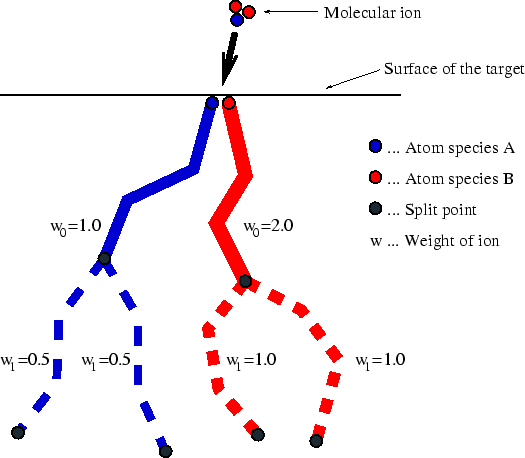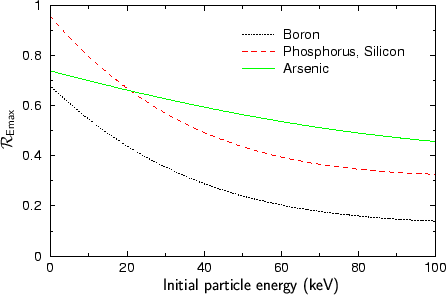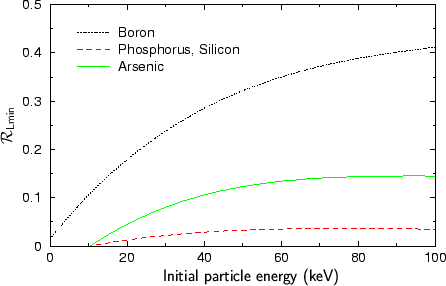


 Previous: 4.6 Speedup Algorithms
Up: 4.6 Speedup Algorithms
Next: 4.6.2 Trajectory-Reuse Method
Previous: 4.6 Speedup Algorithms
Up: 4.6 Speedup Algorithms
Next: 4.6.2 Trajectory-Reuse Method
4.6.1 Trajectory-Split Method
The impurity distribution which is calculated when simulating ion implantation
is proportional to the probability distribution that an implanted ion reaches
a certain area of the simulation domain. Regions where the impurity
concentration is two orders lower than the maximal concentration level in the
simulation domain, are reached just by one of hundred implanted ions. The
situation is even worse at lower concentration regions. A reasonable simulation
result has to represent three to five orders of the impurity concentration,
where at least some particles have to reach the zones of the lowest
concentration to ensure an acceptable statistical accuracy, because from the
presence of just one particle no meaningful concentration information can be
derived.
It is obvious that at least several ten thousands of ion trajectories have to be
simulated to fulfill this requirement where most of these trajectories end up
within regions of a high impurity concentration and therefore do not
significantly contribute to an improvement of the simulation result. To reduce
the number of such irrelevant trajectories the Trajectory-Split method is
applied ([7], [8], [9]).
The fundamental idea is to increase the number of ion trajectories that end up in
regions of low impurity concentration by splitting a particle trajectory in case the
particle moves from a region of higher concentration to a region of lower
concentration as indicated in Fig. 4.17.
Figure 4.17:
Schematic figure how the Trajectory-Split method works especially in
combination with the molecular method.
 |
Splitting means that originating from one particle several new particles are
created with the same physical properties as the original particle, but with a
reduced weighting factor. As mentioned in Sec. 4.5.2 all simulation
results generated during the simulation, like a change in the number of
vacancies, interstitials or impurities are multiplied with the weighting factor
before they are stored. While for the molecular method a
weighting factor larger than one is used to account for statistical identical
particles of the same atom species in a molecule, the weighting factor is
reduced below one by the Trajectory-Split
method to conserve the total implantation dose. According to [7] it
is most efficient to split one particle into two new particles and to apply the
splitting process recursively until a maximum split depth of eight  so that the minimal weight of a particle is
so that the minimal weight of a particle is
 .
.
Various criteria are applied to decide if a particle can be split.
- Energy Criterion:
The splitting of a particle is forbidden if the ratio
 of the
actual particle energy and the initial particle energy is above a minimum energy
threshold level
of the
actual particle energy and the initial particle energy is above a minimum energy
threshold level
 to avoid too many split points.
to avoid too many split points.
 |
(4.9) |
A particle species and energy dependent value for
 is
proposed in [7] for the particle species boron, phosphorus, silicon
and arsenic as shown in Fig. 4.18, while a default value of 0.4
is used for all other particle species
is
proposed in [7] for the particle species boron, phosphorus, silicon
and arsenic as shown in Fig. 4.18, while a default value of 0.4
is used for all other particle species  .
.
Figure:
Default values for
 for the particle species boron,
phosphorus, silicon and arsenic.
for the particle species boron,
phosphorus, silicon and arsenic.
 |
- Trajectory Length Criterion:
The splitting of a particle is forbidden, if the ratio
 of the
length of the trajectory up to the potential split point, and the average
trajectory length, is shorter than the minimal length ratio
of the
length of the trajectory up to the potential split point, and the average
trajectory length, is shorter than the minimal length ratio
 . The average trajectory length is accurately determined
during the simulation, while at the beginning an estimated average length
equivalent to an estimated projected range is used.
. The average trajectory length is accurately determined
during the simulation, while at the beginning an estimated average length
equivalent to an estimated projected range is used.
 |
(4.10) |
As for the energy ratio a particle species and energy dependent value for
 is proposed in [7] for the particle species
boron, phosphorus, silicon and arsenic as shown in Fig. 4.19.
is proposed in [7] for the particle species
boron, phosphorus, silicon and arsenic as shown in Fig. 4.19.
Figure:
Default values for
 for the particle species boron,
phosphorus, silicon and arsenic.
for the particle species boron,
phosphorus, silicon and arsenic.
 |
The default value  for all
other species is 0.1. Due to this criterion mainly particles in the channeling
region are split.
for all
other species is 0.1. Due to this criterion mainly particles in the channeling
region are split.
- Trajectory Density Gradient Criterion:
In the ideal case the aim of the Trajectory-Split method is to reach an equivalent
number of trajectory end points in all histogram boxes independent of the
impurity concentration described by a certain histogram box. Therefore the
trajectory end points are stored in an individual histogram, one for each
particle species. While the weighting factor is considered when storing data in
the normal species histograms this factor is neglected when storing trajectory
endpoints. A particle trajectory is only split if the particle moves from a
region with a higher number of trajectory endpoints to a region with a lower
number of trajectory endpoints. This is checked by defining several levels of
trajectory numbers
 . By default 10 levels are defined
. By default 10 levels are defined

 number of levels number of levels![$\displaystyle ].$](img544.gif) |
(4.11) |
If a particle moves to a region corresponding to a lower
level the trajectory is split if all other requirements for splitting are met.
- Energy Loss Criterion
A particle must loose a certain amount of energy between two trajectory split
points. According to [7] it significantly improves the efficiency
of the Trajectory-Split method if this minimal energy loss
 is
6.6 % of the minimal energy for splitting according to the energy criterion.
is
6.6 % of the minimal energy for splitting according to the energy criterion.
 initial particle energy initial particle energy |
(4.12) |
To guarantee that two split trajectories are not identical after a split point
there must at least one effect in the calculation of a particle trajectory which
randomly influence the motion of the particle. If this is not the case two
trajectory split branches are identical because the initial conditions at
the split point are identical. In that case the Trajectory-Split method does
not yield any performance gain. It would even significantly decrease the
performance because because identical trajectory would be calculated several times.
In crystalline materials the vibration of the lattice atom guarantees this
randomness while in amorphous materials the collision partners are placed
randomly. Nevertheless, the Trajectory-Split method is only applied within
crystalline materials, because its original intention was to improve the
statistical accuracy in the channelling regions.
The effect of the Trajectory-Split method is that one implanted ion delivers
several effective ions which share the initial part of the
trajectory. Therefore less initial ions have to be used to generate a
simulation result with the same statistical accuracy. Due to the sharing of
parts of the trajectories the average calculation time for a trajectory of one
effective ion is reduced. Worth mentioning is that in case of applying the
Follow-Each-Recoil method the recoiled atoms are not split, because the number
of recoils is already significantly higher than the number of implanted
particles.
Footnotes
- ... eight

- Instead of using the default value for the split
depth a value can be specified by the command-line parameter nbSplitLevel.
- ... species

- The value of
 can also be set by the command-line parameter relativeSplitEnergy.
can also be set by the command-line parameter relativeSplitEnergy.
- ... value

- It can be
overridden by the command-line parameter relativeSplitLength.
- ... defined

- The number of levels can be defined by the command-line parameter
nbConcentrationLevel.



 Previous: 4.6 Speedup Algorithms
Up: 4.6 Speedup Algorithms
Next: 4.6.2 Trajectory-Reuse Method
Previous: 4.6 Speedup Algorithms
Up: 4.6 Speedup Algorithms
Next: 4.6.2 Trajectory-Reuse Method
A. Hoessiger: Simulation of Ion Implantation for ULSI Technology



